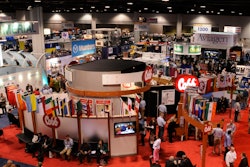It’s been nearly 200 years since the railroad boom began to change the landscape of North America. Although many of the basic track components are still the same — ties, rail, spikes, plates and frogs — how they come together has changed quite dramatically, particularly in the past 10 years.
The track on which railroads and connecting industries operate is being reconfigured, rehabilitated and expanded to accommodate not only the growing volume of trains but also longer and heavier trains and cars. Doing business with railroads now requires meeting their more demanding standards. Railroad track and operating requirements are designed to help them run safer, more productive, scheduled operations. The good news is these mandates also can produce efficiency benefits for your operation as well.
When it comes to maximizing track efficiencies, there are lots of variables and options to consider. An experienced track contractor can help evaluate the alternatives and work closely with servicing railroads to not only meet their requirements, but also secure input and buy-in for your plans.
Biannual track inspections help maximize productivity
The days are gone when railroad representatives routinely inspected industrial track and suggested action plans. You can’t count on railroads to alert you to track defects. Railroad inspectors generally examine track only when they suspect a defect or safety concern. More times than not, you will only know there is a problem when a car leaves the track and the railroad notifies you they have discontinued service until your track has been repaired. This also comes with an invoice for rerailing cars.
It is your responsibility to maintain your own track and ensure it complies with railroad and FRA requirements.
If they find a serious defect, the railroad will not hesitate to “red flag” or discontinue service until repairs are completed. This hopefully happens before a serious accident or derailment.
Taking a preventive approach will cost less in the long run and eliminate problems associated with a track outage, including safety risks, shipping delays, demurrage charges, rerailing or derailment services, unexpected, unfunded repairs and bad publicity. That begins by performing routine housekeeping to keep track clear of grain and product debris and turning to a qualified track contractor to conduct inspections twice a year, generally in the fall and spring.
A thorough inspection involves walking the entire track, evaluating the subgrade and drainage, rail, ties, ballast and turnouts, including switches and frogs. Oftentimes the inspection team will perform routine maintenance, such as adjusting switches and tightening bolts. If a pressing deficiency is identified, the contractor will notify the facility manager so immediate action can be taken. A few days after the inspection, the contractor will present a report detailing a track evaluation and an assessment of each turnout in the facility. The contractor also will provide a long-term capital spending plan as a tool for the budget process. On-going inspections and maintenance help eliminate huge financial surprises that occur when track is not maintained properly.
Track rehabilitation programs range from catch-up to rail replacement
Any track rehabilitation program should take into account these factors:
- The facility’s business objectives and expansion prospects
- Servicing railroad regulations and operating plans and schedules
- Carloadings per year
- Loads vs. empties
- Environmental impacts, including geographic constraints
- Overall existing track conditions: drainage and rail, tie and switch conditions
- The use of standard rail sections deemed acceptable by serving railroads
A typical catch-up track rehab scenario for a grain facility involves replacing approximately 10% of cross ties and 50% of switch ties and resurfacing the track. This program addresses the weakest components first and assumes the rail is in satisfactory condition. Cost estimates can range greatly, from $15,000 and up depending on the factors previously mentioned.
A more extensive rehabilitation program may be necessary if the rail is not adequate to accommodate higher capacity grain cars now used on longer, heavier trains. Heavy train weights require changing out older, lighter rail sections and switches with a minimum of 112-pound components. At one time every railroad in the country had its own idea of what weight rail should be. More than 100 different variations of rail sections have been manufactured in the past and can currently be found on industry track. Over time the railroads have standardized to a few sections: 112, 115, 132, 133, and 136-pounds. More recently heavy-haul railroads have begun using 141-pound rail.
Over time every facility with track under 112-pound rail needs to make plans to replace it with a heavier, more standard section of rail. To spread out the capital outlay, we recommend changing out a portion each year and saving old rail for maintenance for the remainder of track until it has all been changed out. It is increasingly difficult to find some of these older sections of rail for maintenance use. As the price of scrap increases, these older sections are being scrapped and no longer kept in inventory.
Track expansion or reconfiguration to add capacity
Many grain facilities find railroads are moving away from using local switch engines to service customers and instead are using actual freight trains. These trains stop and drop off the cars or pick them up for their final destination.
This operating practice has implications for the track structure at grain facilities. In addition to decreasing the service frequency, it means when you do get service your facility must accommodate the unit train capacity dictated by your serving railroad. These practices may change as time goes by with ongoing modifications in car lengths and capacities, locomotive capabilities as well as requirements on the train’s receiving end.
Several track expansion alternatives address more demanding requirements from serving railroads and also make operations more fluid and productive, offering greater flexibility to load and store cars. These improvements ultimately help provide growers with better pricing and service and may offer a competitive advantage:
- Extend or add sidings
- Reconfigure a stub track into a run-around track or siding
- Relocate the existing main-line turnouts
A qualified railroad contractor can help you evaluate these options and associated costs based on your operations and the physical dimensions of your facility site.
Track considerations for new facilities
An evaluation of the potential or existing site property, along with the facility’s capacity expectations, will help narrow track configuration alternatives for your new facility. This process should get started as early as possible, generally six months to two years before any dirt work is started. The track contractor will evaluate the site topography, often with the general contractor, a railroad representative and/or an engineering firm, to determine the project feasibility and design implications, such as grading and drainage requirements and access to the serving railroad.
- Ladder track (multiple tracks and turnouts) — These configurations save on width of land but may require substantial footage (length) adjacent to the existing main line.
- Loop, double-loop and teardrop tracks — Serving railroads generally welcome these configurations because they provide for more fluid rail operations. However, the options require a minimum 7,200 feet of track on at least 80 acres of land.
Based on the property and its access to rail services, the track contractor can determine design requirements and develop a cost-effective design and construction proposal. The contractor will then coordinate with the railroad to determine access requirements and develop a track plan that meets the serving railroad’s design requirements and track construction specifications. Once preparatory site grading is completed, the track construction begins. Depending on the project scope, construction can take from weeks to several months.
When it comes to railroad track, it may look similar to your granddad’s or father’s track, but it’s definitely not the same. Times have changed. Those facilities that protect their track investment will realize not only productivity improvements, but also competitive advantages that will positively impact their entire business.

















